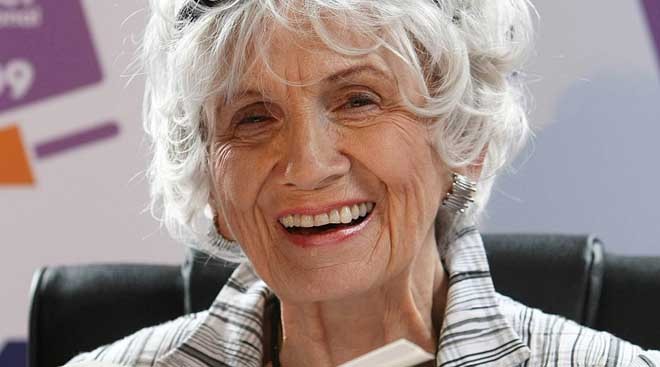

At the end of the year, it makes a fitting farewell to write about one prize that shines every year. This year the Nobel in Literature went to Alice Munro. The first Munro story I ever read was The Albanian Virgin. Detailed with the sensibility of its characters, Munro’s work is a treat to read.
At 82, she was a bit more gracious about the Nobel then her predecessor by some years, Doris Lessing. Lessing uttered "Oh Christ!" upon being told of the Nobel, Munro did not say a lot either. Due to her frail health she was unable to go to the Nobel ceremony and they played the video of an interview she had recorded earlier.
For a bit of literary fracas Bret Easton Ellis, author of American Psycho even tweeted that Munro is over-rated but had to take back his remarks in the face of excessive backlash on the internet.
Munro’s writings have received different reactions -- some praiseworthy and some not so.
The truth is, in order to pronounce a remark like Ellis’, one must also furbish the criteria upon which to base the remark. Surely, everyone is entitled to an opinion but, in public discourse, opinions are questioned and then must be substantiated if one intends to stick by them. Ellis took back his remark saying he felt as if he had beaten Santa Claus. It would have been more laudatory had he substantiated it.
Munro is a master of the short story but she never succeeded as a novelist. Of her abortive attempt at writing a novel, she says she realised it was not making sense. For a writer to be taken seriously, one might say the novel decides the matter. What Munro has achieved is a type of fiction that has no need to be measured against the novel; for the medium of short story, she has mastered the technique.
Her short stories often overlap but they are always loosely structured with no semblance to what a novel may be even in embryo.
William Faulkner, who also wrote about the American south, is a writer whose locality leaves a mark upon Munro’s work. Ontario, Canada is what Munro has made her own. Small town lives and working class women -- from them comes Munro’s slice of life
Her writing is realistic but it is a realism of detail, of paying close attention to the sensibility of her characters. Her writing brings all types of people to the forefront of her canvas.
In any work by Munro, the atmosphere, locality and characters interact in such a way that to the reader the pleasure lies in seeing how the elements merge. An image of what houses look like, a tall, two-store wooden house with a verandah, a bit of gray sky, and Flora hanging up a clothes line, stays with one even after years of reading.
In her story, Friend Of My Youth, the writer narrates a story that her mother told her about staying with Flora and Ellie, in her youth. The landscape is described in words that are simple but the wealth of detail that comes with her writing evokes a profound atmosphere which simply sticks to one’s mind.
"Well drained fields with none of the Precambrian rock shouldering through the soil, a little willow-edged river running alongside, a sugar bush, log barns, and a large, unornamented house whose wooden walls had never been painted but had been left to weather. And when wood weathers in Ottawa valley, my mother said, I do not know why this is but it never turns gray, it turns black."
The long sentences interspersed with commas; the first person pronoun in the next line while the story is told by someone else lends an air of intimacy to the whole account.
Natalie Goldberg mentions rhythm in her book. In Writing Down the Bones, she says that every writer has a rhythm of her own breath and of sentences that comes with it. Not only is there a pleasure in reading and imagining this detail; for the reader it also becomes an account more personal because the detail takes one inside the story. The sentences move along the way we often listen to a story with the rise and fall of cadence. They fit themselves around the distances between one breath and the next.
As a housewife who was running a bookshop, Munro mentions,"I can’t play bridge. I don’t play tennis. All those things that people learn, and I admire, there hasn’t seemed time for. But what there is time for is looking out the window." The writer’s picture becomes very clear with this pastime of looking out the window. It is in these periods of silences that writers write.
In one of her interviews, Munro has mentioned that she started writing because she was bent upon imagining a happier ending for The Little Mermaid, the story by Hans Christian Anderson. It didn’t matter that she could not publish this ending but it calmed her to know that she could, indeed, think of another ending that need not be tragic.
Surprisingly, Munro found it was easier to create unhappy, and later on tragic, endings for her characters. According to her, it was only recently that she started to make her peace with happier endings.
All her life, Munro wrote about what she knew, the lives she understood or tried to understand through the medium of her writing. Earlier this year, Munro called it quits. For her, Philip Roth set the path blasing by taking a retirement from the life of a writer. "There is a nice feeling about being just like everyone else now." She no longer needs to live and then simulate that life in writing. Now life can be lived for its own sake. Her last book was Dear Life, a collection of short stories.